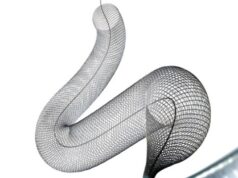
The Flow Redirection Endoluminal Device stent system (FRED; MicroVention)—a flow diverter used to treat intracranial aneurysms—has been deemed safe and effective for this indication, following a multicentre pivotal trial designed to support an application for US Food and Drug Administration (FDA) approval. The results of this study are published in the Journal of NeuroInterventional Surgery (JNIS).
In their report, Cameron G McDougall (Department of Neurosurgery, Johns Hopkins Hospital, Baltimore, USA) et al note: “Although the FRED system is a relative newcomer to the flow diversion field, a growing body of high-quality evidence consistently shows it provides satisfactory safety and efficacy results.”
The authors add that—while differences between this trial and similar studies intended to support FDA approval of flow diverter devices mean caution should be exercised when comparing their outcomes—the “very low” rates of disabling stroke or death seen in the FRED pivotal trial are “reassuring”, as they have been consistently reflected in other recent major trials of the device. In addition, this trial and others involving the FRED system have reported “improving rates of complete aneurysm occlusion over time”—as seen in studies of Medtronic’s Pipeline embolisation device as well.
“As compared with historically-derived performance benchmarks, the US FRED pivotal trial successfully achieved favourable outcomes for the primary endpoints of both safety and efficacy in the treatment of intracranial aneurysms,” McDougall and colleagues conclude.
The authors report that, for this multicentre, prospective, single-arm, investigational device exemption (IDE) clinical study, a total of 145 patients with aneurysms of unfavourable morphology for traditional endovascular therapies—including large, wide-necked and fusiform—were enrolled across 23 centres, and underwent attempted placement of the FRED device. The primary safety endpoint was death or major stroke (National Institutes of Health Stroke Scale [NIHSS] score ≥4 points) within 30 days of the procedure, or any major ipsilateral stroke or neurological death within the first year. The primary effectiveness endpoint was complete occlusion of the target aneurysm with ≤50% stenosis of the parent artery at 12 months after treatment, and in which an alternative treatment of the target intracranial aneurysm had not been performed.
All 145 patients had one or more FRED devices placed, McDougall et al note, with the majority of these (93%) having a single device placed, while nine patients (6.2%) had two devices deployed, and one (0.7%) had three devices deployed. Of the 155 devices implanted to deal with the target aneurysm across the patient cohort, three were placed during reintervention procedures—with the authors stating that these reinterventions were considered as treatment failures for the purposes of the study.
After one year of follow-up (within 425 days), nine patients (6.2%) met the composite primary safety endpoint of major stroke or death within 30 days, or major ipsilateral stroke or neurological death after 30 days. The performance goal of <15% was therefore met, the authors report. At last follow-up, among the nine patients who had met the safety endpoint, death or disabling stroke occurred in four, while five had recovered to a modified Rankin Scale (mRS) score of ≤2. “No significant differences in the rate of primary safety endpoint (or safety subcomponent) events were noted in relation to patient age or gender, nor in relation to aneurysm size or rupture status,” McDougall et al add. “There were no unexpected adverse device effects during this trial.”
Regarding effectiveness, 80 of the 139 patients (57.6%) with angiograms interpretable at follow-up met the criteria for primary effectiveness—that being complete aneurysm occlusion without stenosis >50%, and no retreatment. McDougall and colleagues note that one secondary endpoint, an alternative definition of successful occlusion defined as the number of patients with clinically acceptable occlusion (90–100%), <50% stenosis of the parent artery, and without unplanned alternative treatment, was observed in 100 of these patients (71.9%).
The authors also state that there were reports of “device thrombosis” in 12 patients (8.3%), resulting in two experiencing major strokes, three experiencing minor strokes, and two experiencing transient ischaemic attacks (TIAs). Stenosis of >50% at 12-month follow-up was observed in six patients—two of whom were symptomatic.
The “chief limitation” of the study was the lack of a control group, McDougall et al note, with significant differences in key features, such as allowed anatomical sites of included aneurysms, size and other aneurysm characteristics, and treatment-related issues like the number of devices used, making comparison with other trials “difficult”. Nevertheless, based on this US pivotal trial meeting its safety and effectiveness endpoints, the FDA granted MicroVention premarket approval for the FRED system in January 2020, they report.













